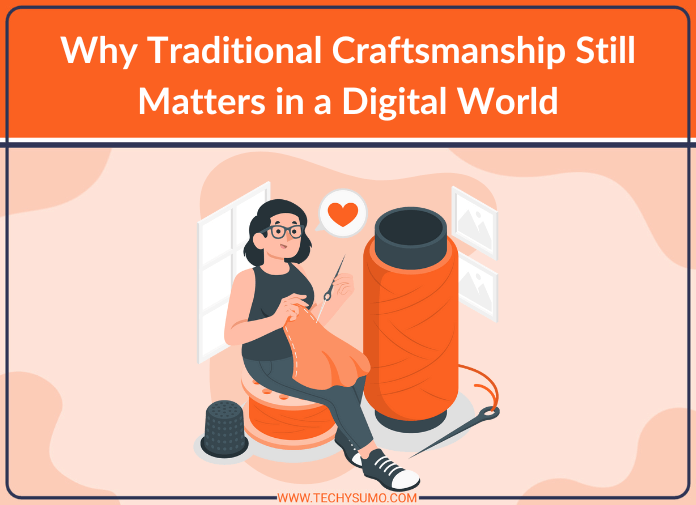In an era where mass production and automation dominate nearly every industry, the value of traditional craftsmanship can sometimes feel overshadowed. Digital manufacturing and artificial intelligence have revolutionized the way we create, distribute, and consume goods—but does that mean handcrafted art and design are becoming obsolete? Far from it.
Traditional craftsmanship remains as relevant as ever, offering a level of authenticity, cultural heritage, and longevity that machine-made goods often lack. Whether it’s handwoven textiles, artisanal ceramics, or meticulously crafted furniture, these time-honored skills carry deep meaning and provide value that technology alone cannot replicate.
Here’s why craftsmanship continues to hold an essential place in today’s world—and why it will always matter.
Table of Contents
- The Irreplaceable Human Touch in Design
- What Makes Handcrafted Items Special?
- Craftsmanship and Sustainability: A Necessary Shift
- How Craftsmanship Supports Sustainability:
- The Cultural Significance of Traditional Craftsmanship
- Preserving Cultural Heritage Through Craftsmanship
- The Role of Craftsmanship in Modern Design
- Why Designers Still Seek Handcrafted Pieces:
- Why Craftsmanship Will Always Matter
The Irreplaceable Human Touch in Design
Every handcrafted item carries a unique signature—a testament to the skill, patience, and creativity of the artisan behind it. Unlike mass-produced goods, which often prioritize efficiency over individuality, handcrafted pieces are made with attention to detail that no machine can fully replicate.
What Makes Handcrafted Items Special?
- Imperfections That Add Character – Unlike factory-made products, handcrafted items often feature subtle variations, making each piece one of a kind.
- Quality Over Quantity – Craftsmanship values durability and longevity, whereas mass production often focuses on cost-cutting and disposable trends.
- A Connection to the Creator – When you buy something handmade, you’re supporting a real person’s skill and livelihood rather than an impersonal assembly line.
While technology can create perfect replicas, it cannot infuse objects with the soul, care, and artistry that a human craftsman can.
Also Read
Craftsmanship and Sustainability: A Necessary Shift

In a world increasingly concerned with environmental impact, traditional craftsmanship plays a crucial role in sustainability. Many artisans use ethically sourced, natural materials and create products designed to last for generations—unlike cheaply made, disposable goods that contribute to global waste.
How Craftsmanship Supports Sustainability:
- Handmade goods often use fewer resources compared to mass-produced alternatives, reducing environmental strain.
- Durability over disposability means that a handcrafted piece, whether furniture, clothing, or decor, is meant to last decades rather than just a few years.
- Local sourcing and production reduce carbon footprints by eliminating the need for large-scale shipping and excessive packaging.
By investing in artisanal goods, consumers can move away from fast fashion and mass-produced home décor, opting instead for high-quality, sustainable alternatives.
The Cultural Significance of Traditional Craftsmanship
Many traditional crafts are deeply tied to cultural heritage, telling the stories of generations before us. Whether it’s weaving, pottery, metalwork, or woodworking, these skills are often passed down through families, preserving history and identity.
One of the most renowned examples of this is Persian rug-making—a centuries-old tradition that has been refined and perfected over time.
Preserving Cultural Heritage Through Craftsmanship
- Handwoven Persian rugs are not just floor coverings; they are works of art that tell stories through intricate patterns and rich symbolism.
- Every region has its own distinctive style, materials, and techniques, showcasing the cultural identity of the artisans behind them.
- By purchasing handcrafted cultural goods, consumers contribute to the preservation of these ancient skills and support artisans who rely on their craft.
If you’re looking to invest in an authentic piece of history, you can shop Persian rugs online to find high-quality, handwoven pieces that bring both artistry and tradition into your home.
As the digital world advances, it’s vital to protect and celebrate cultural craftsmanship before these skills become lost to automation.
The Role of Craftsmanship in Modern Design

While traditional craftsmanship is rooted in history, it continues to influence modern design. Today, many interior designers, architects, and fashion houses are blending handmade elements with contemporary aesthetics to create spaces and products that feel both timeless and fresh.
Why Designers Still Seek Handcrafted Pieces:
- Texture and Depth – Handcrafted items bring warmth and uniqueness to modern interiors, preventing sterile, mass-produced looks.
- Customization – Artisanal work allows for bespoke creations that cater to individual tastes.
- Emotional Connection – Handmade pieces add personality and soul to a space, telling a story beyond just their function.
From hand-thrown ceramics in minimalist kitchens to handwoven textiles in high-end fashion, craftsmanship continues to shape modern aesthetics in meaningful ways.
Why Craftsmanship Will Always Matter
As the world continues to embrace automation and mass production, traditional craftsmanship remains a counterbalance—reminding us of the beauty of human touch, cultural heritage, and sustainable design. Whether it’s a meticulously handwoven Persian rug, a custom woodwork piece, or an artisan-made ceramic vase, these objects hold meaning beyond their function.
Craftsmanship is not just about making things; it’s about preserving stories, celebrating skill, and valuing quality over convenience. In a digital world that often prioritizes speed and efficiency, there is something truly special about owning—and appreciating—something made by hand.






